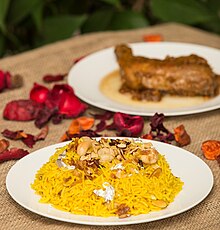Pilaf
Pilaf (US: /ˈpiːlɑːf/), pilav or pilau (UK: /ˈpiːlaʊ, piːˈlaʊ/) is a rice dish, or in some regions, a wheat dish, whose recipe usually involves cooking in stock or broth, adding spices, and other ingredients such as vegetables or meat,[1][note 1][2][note 2] and employing some technique for achieving cooked grains that do not adhere.
[1] Although the cultivation of rice had spread much earlier from India to Central and West Asia, it was at the time of the Abbasid Caliphate that methods of cooking rice which approximate modern styles of cooking pilaf at first spread through a vast territory from Spain to Afghanistan, and eventually to a wider world.
According to author K. T. Achaya, the Indian epic Mahabharata mentions an instance of rice and meat cooked together.
Also, according to Achaya, "pulao" or "pallao" is used to refer to a rice dish in ancient Sanskrit works such as the Yājñavalkya Smṛti.
[17] However, according to food writers Colleen Taylor Sen and Charles Perry, and social theorist Ashis Nandy, these references do not substantially correlate to the commonly used meaning and history implied in pilafs, which appear in Indian accounts after the medieval Central Asian conquests.
[21] Similar stories exist of Alexander introducing pilaf to Samarkand; however, they are considered apocryphal by art historian John Boardman.
[25] Pilau became standard fare in the Middle East and Transcaucasia over the years with variations and innovations by the Persians, Arabs, Turks, and Armenians.
Common additions include fried onions and fragrant spices like cardamom, bay leaves and cinnamon.
[27] In Afghan cuisine, Kabuli palaw (Persian : کابلی پلو) is made by cooking basmati with mutton, lamb, beef or chicken, and oil.
Medium-long grain rice is used, and it is cooked plainly with butter, resulting in a soft yet non-sticky texture.
[30] Armenian recipes may combine vermicelli or orzo with rice cooked in stock seasoned with mint, parsley and allspice.
[31] One traditional Armenian pilaf is made with the same noodle rice mixture cooked in stock with raisins, almonds and allspice.
[32] Armenian kinds of rice are discussed by Rose Baboian in her cookbook from 1964 which includes recipes for different pilafs, most rooted in her birthplace of Antep in Turkey.
Traditional Azerbaijani plov consists of three distinct components, served simultaneously but on separate platters: rice (warm, never hot), gara (fried beef or chicken pieces with onion, chestnut and dried fruits prepared as an accompaniment to rice), and aromatic herbs.
[37] In Bangladesh, pulao (পোলাও), fulao, or holao, is a popular ceremonial dish cooked only with aromatic rice.
Bangladesh cultivates many varieties of aromatic rice which can be found only in this country and some surrounding Indian states with predominantly Bengali populations.
A significantly modified version of the recipe, often seen as influenced by what is called arroz pilau there, is known in Brazil as arroz de frango desfiado or risoto de frango (Portuguese: [ɐˈʁoz dʒi ˈfɾɐ̃ɡu dʒisfiˈadu], "shredded chicken rice"; [ʁiˈzotu], "chicken risotto").
Rice lightly fried (and optionally seasoned), salted and cooked until soft (but neither soupy nor sticky) in either water or chicken stock is added to chicken stock, onions and sometimes cubed bell peppers (cooked in the stock), shredded chicken breast, green peas, tomato sauce, shoyu, and optionally vegetables (e.g. canned sweet corn, cooked carrot cubes, courgette cubes, broccolini flowers, chopped broccoli or broccolini stalks or leaves fried in garlic seasoning) or herbs (e.g., mint, like in canja) to form a distantly risotto-like dish – but it is generally fluffy (depending on the texture of the rice being added), as generally, once all ingredients are mixed, it is not left to cook longer than five minutes.
In the Eastern Caribbean and other Caribbean territories there are variations of pelau which include a wide range of ingredients such as pigeon peas, green peas, green beans, corn, carrots, pumpkin, and meat such as beef or chicken, or cured pig tail.
[39] Central Asian, e.g. Uzbek, Kyrgyz and Tajik (Uzbek: Osh, Palov, Kyrgyz: Аш, палоо, Tajik: Палов) Kazakh, Turkmen, Karakalpak (Kazakh: Палау, Palaw) or osh differs from other preparations in that rice is not steamed, but instead simmered in a rich stew of meat and vegetables called zirvak (зирвак), until all the liquid is absorbed into the rice.
Plov is usually simply spiced with salt, peppercorns, and cumin, but coriander, barberries, red pepper, or marigold may be added according to regional variation or the chef's preference.
In Xinjiang, where the dish is known as polu, it is often served with pickled vegetables, including carrots, onion and tomato.
[43] In Greek cuisine, piláfi (πιλάφι) is fluffy and soft, but neither soupy nor sticky, rice that has been boiled in a meat stock or bouillon broth.
Pulao is usually a mixture of either lentils or vegetables, mainly including peas, potatoes, green beans, carrots or meat, mainly chicken, fish, lamb, goat, pork or prawn with rice.
A typical Bengali style pulao is prepared using vegetarian ingredients like Long grain rice or aromatic rice, cashewnut, raisin, saffron, ghee and various spices like nutmeg, bay leaf, cinnamon, cardamom, cumin, clove and mace.
Typically non-spicy, it features tender pieces of meat, such as chicken, lamb, or beef, though vegetarian variations are also popular.
The dish is made with beef, basmati rice, and a blend of local spices, resulting in a flavor profile characteristic of the region.
[47][48] Romanian style pilaf is often more watery in consistency, more akin to congee, and uses chicken breast meat along with chopped red peppers, onion, and carrot.
The rice pilaf which is traditionally cooked with meats, eggplants, tomatoes, potatoes, and cauliflower also has a fish variety known as "Sayyadiyeh", or the Fishermen's Dish.
[55] Traditional Crimean Tatar pilyav (pilâv) is prepared from rice; meat, onions, or raisins can be added.











